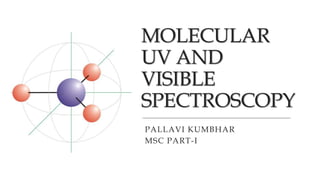
UV Visible Spectroscopy
- 2. CONTENTS 01 Introduction 02 Derivation of Beer Lambert’s Law 03 Limitations 04 Factors Affecting molecular absorption 05 Applications of Ultraviolet and Visible spectroscopy 06 References
- 3. INTRODUCTION Molecular spectroscopy is the study of absorption of light by molecules. The principle of molecular absorption spectroscopy is based on electromagnetic radiation in the wavelength region of 190 to 800 nm. Molecular absorption spectroscopy in the ultraviolet and visible spectral regions is widely used for the quantitative determination of a large number of inorganic, organic, and biological species in various laborataries throughout the world.
- 4. Derivation of Beer- Lambert’s Law Po= Radiation of initial radiant power P = transmitted power c = number of moles per litre b = path length in cm. n = absorbing atoms, ions, or molecules S = area of the cross section of the block dx = infinitesimal thickness dS = The total projected area of capture surfaces within the section The ratio of the capture area to the total area is dS/S Px = power of the beam entering the section dP = power absorbed within the section -dP/Px represents the ratio of the average probability for capture. The term is given a minus sign to indicate that the radiant power P decreases as it passes through the absorbing region. Thus, − 𝑑𝑃𝑥 𝑃𝑥 = 𝑑𝑆 𝑆 ….(1)
- 5. dS is the sum of the capture areas for particles within the section; it is therefore proportional to the number of particles, dS= adn ….(2) where dn is the number of particles and a is a proportionality constant, which can be called the capture cross section. Substituting Equation(2) in equation(1) and integrating over the interval between 0 and n, we obtain − Po P d𝑃𝑥 𝑃𝑥 = 0 n adn S When these integrals are evaluated, we find that −ln P 𝑃0 = an S After converting to base 10 logarithms and inverting the fraction to change the sign, we obtain log Po P = an 2.303S
- 6. The cross-sectional area S can be expressed as the ratio of the volume of the block V in cubic cm to its length b in cm. Thus, S = V b cm2 Substitution of this quantity to the above equation yields 𝑙𝑜𝑔 Po P = anb 2.303V ….(3) n/V can be converted to moles per litre because the number of moles is given by No. of moles = n particles 6.02x1023particles/mol therefore c in moles per litre is given by c = n 6.02x1023 mol × 1000cm3/L Vcm3 n V = c×6.02x1023 1000 mol/L Combining this relationship with Equation (3) yields log Po P = 6.02x1023abc 2.303 × 1000 Finally, the constants in this equation can be collected into a single term ε to give log Po P = εbc = A which is known as Beer Lambert’s law.
- 7. LIMITATIONS 1) Beer Lambert's law shows the absorption behavior of media containing only low analyte concentrations (usually <0.01M). Therefore it is a limiting law. 2) At high concentrations (usually >0.01 M), the extent of solute- solvent interactions, solute-solute interactions, or hydrogen bonding can affect the analyte environment and its absorptivity. 3) The extent of interaction depends on concentration. Due to this, deviations from the linear relationship between absorbance and concentration occur. 4) Absorptivity depends on the refractive index of the medium. Therefore if concentration changes, significant alterations in the refractive index n of a solution arises which causes
- 8. FACTORS AFFECTING MOLECULAR ABSORPTION Common factors that influence the absorption spectrum of a substance include 1) the nature of the solvent 2) the pH of the solution 3) the temperature 4) high electrolyte concentrations and 5) the presence of interfering substances. The effects of these factors must be known and conditions for the analysis must be chosen such that the absorbance will not be materially influenced by small uncontrolled variations in their magnitudes.
- 9. APPLICATIONS OF ULTRAVIOLET & VISIBLE SPECTROSCOPY 1. Charge transfer absorption For quantitative purposes, charge-transfer absorption is particularly important because molar absorptivities are unusually large (ε >10,000), which leads to high sensitivity. 2. Derivative spectroscopy Concentration measurements of an analyte in the presence of an interference or of two or more analytes in a mixture can be made more easily or more accurately using derivative methods.
- 10. 1. A charge-transfer complex consists of an electron donor group bonded to an electron acceptor. 2. When this product absorbs radiation, an electron from the donor is transferred to an orbital which accepts electron. The excited state is the product of internal oxidation-reduction process. 3. For eg: The red colour of the iron(III)- thiocyanate complex. 4. In most charge-transfer complexes involving a metal ion, the metal serves as the electron acceptor. But there are some exceptions where the ligand is the acceptor and the metal ion is the donor. CHARGE TRANSFER ABSORPTION
- 11. 1. In derivative spectroscopy, spectra are obtained by plotting the first- or a higher-order derivative of absorbance with respect to wavelength as a function of wavelength. 2. Applications of derivative spectroscopy in the ultraviolet and visible regions, a. Used for qualitative identification of species. b. Useful for the simultaneous determination of two or more components in mixtures. c. Used to determine trace metals in mixtures. d. Widely applied to pharmaceutical preparations and to vitamin mixtures. 3. Disadvantage of Derivative spectroscopy. DERIVATIVE SPRECTROSCOPY
- 12. REFRENCES • Principles of Instrumental Analysis by Skoog, Holler and Crouch. • Images from Google.